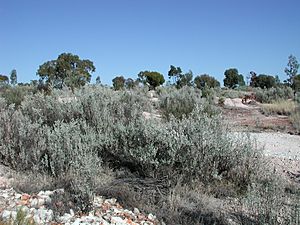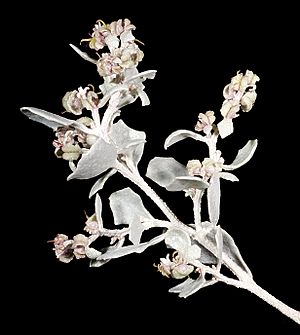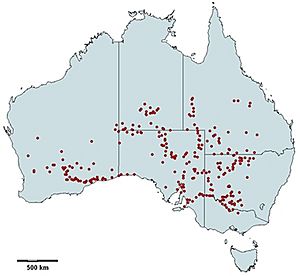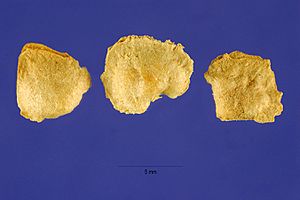Oldman saltbush facts for kids
Quick facts for kids Oldman saltbush |
|
|---|---|
 |
|
 |
|
| Scientific classification | |
| Genus: |
Atriplex
|
| Species: |
nummularia
|
 |
|
| Occurrence data ALA | |
| Synonyms | |
|
Atriplex johnstoni |
|
Oldman Saltbush (scientific name: Atriplex nummularia) is a large, woody shrub that originally comes from Australia. You can now find it in other parts of the world, like North America, Africa, and Asia. This plant is special because it can grow in tough places where other plants can't survive, such as very salty or dry areas. Its name "Saltbush" comes from its amazing ability to handle salty soil. It actually takes salt from the soil and stores it in its leaves. When the leaves get too salty, they fall off, helping the plant get rid of the extra salt.
Contents
What Does Oldman Saltbush Look Like?
Oldman Saltbush is a very interesting plant! Here are some of its main features:
How Big Does It Get?
This plant can grow up to 10 feet (about 3 meters) tall and wide. That's taller than most kids!
What About Its Leaves?
The leaves are a cool silvery-gray color and are shaped like ovals. They have tiny hairs that help reflect sunlight and stop the plant from losing too much water. You can even eat the leaves, but be warned, they taste salty!
What Are Its Stems Like?
The stems are woody and can be quite thick. They help the plant stand tall and carry water and nutrients to all its parts.
Flowers and Reproduction
Oldman Saltbush has small, simple flowers that are usually green or yellowish. They might not be super colorful, but these flowers are very important for the plant's reproduction.
Fruits and Seeds
The fruits are small, papery little structures, and each one holds a single seed. These seeds can travel by wind, water, or even by animals, helping the plant spread.
Roots: Finding Water in Dry Places
The roots of the Oldman Saltbush grow deep and spread out widely. This helps the plant find water even in very dry areas. The roots also help hold the soil in place, stopping erosion.
Where Does Oldman Saltbush Grow Best?
Oldman Saltbush is a very tough plant that can live in many different places. However, it is most often found in:
- Dry and Semi-Dry Areas: These are places that don't get much rain, like deserts and grasslands.
- Salty Soils: These soils have a lot of salt, which can be harmful to many other plants.
- Disturbed Lands: These are areas that have been changed by people, such as roadsides, building sites, or pastures where too many animals have grazed.
In Australia, Oldman Saltbush grows in many states and territories, including New South Wales, Victoria, South Australia, Western Australia, and the Northern Territory. It's a very important part of the Australian landscape and plays a big role in the natural environment.
Why Is Oldman Saltbush So Important?
Oldman Saltbush is important for several reasons:
- Helping the Soil: Its deep roots help keep the soil from washing or blowing away. This is super important in dry and windy places.
- Home for Wildlife: It provides food and a safe place for many animals, including birds, mammals, and insects.
- Food for Farm Animals: It's a good food source for farm animals like sheep and cattle, especially when there's a drought and other plants are hard to find.
- Fixing Damaged Land: This plant can be used to help bring life back to damaged areas, like overgrazed pastures or old mine sites.
- Fighting Climate Change: It helps take carbon dioxide out of the air and stores it in its leaves, stems, and the soil. This can help slow down climate change.
- Food for People: The leaves can be eaten in salads, soups, and other dishes. They have a salty taste and are full of good minerals.
History and Uses of Oldman Saltbush
Aboriginal Australians have used Oldman Saltbush for thousands of years. They used it for food, medicine, and other things. They ate the leaves fresh or cooked them, and they made a special tea from the roots for medicine. The plant was also used to make dyes and fibers.
When European settlers came to Australia, they also saw how useful Oldman Saltbush was. They used it to feed their livestock and to help fix damaged land. In the 1800s and 1900s, many tests were done to see how well Oldman Saltbush could help with farming and making land healthy again.
Today, Oldman Saltbush is still used for many of the same reasons. It's a key plant for sustainable agriculture (farming that protects the environment) and land management in Australia and around the world.
Fun Facts About Oldman Saltbush!
- Oldman Saltbush can live for more than 50 years!
- It can handle very hot temperatures, up to 122°F (50°C), and also cold temperatures, down to 14°F (-10°C).
- It can grow in soils that have a lot of salt, up to 4% salt concentration.
- It's a popular plant for gardens in dry areas because it doesn't need much water and is easy to care for.
- You can even use its leaves to make a natural soap!
Protecting Oldman Saltbush
Atriplex nummularia grows in several protected areas, especially in New South Wales, Australia. These places help keep the plant safe:
- Kinchega National Park
- Mungo National Park
- Murrumbidgee Valley National Park
- Mutawintji National Park
- Paroo-Darling National Park
- Sturt National Park
- Yanga National Park
Gallery
See also
 In Spanish: Zampa australiana para niños
In Spanish: Zampa australiana para niños





